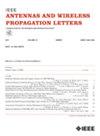提高高频比单馈双带微带阵列的孔径效率
IF 4.8
2区 计算机科学
Q2 ENGINEERING, ELECTRICAL & ELECTRONIC
引用次数: 0
摘要
双频微带天线(MSA)阵列广泛应用于高增益的应用中。然而,对于具有高频率比(FR)的单馈源双频MSA阵列,同时获得两个波段的孔径效率是具有挑战性的。传统的方法需要单独的元件作为不同的散热器,低频(LF)元件通常占用较大的面积,但不参与高频辐射,导致孔径效率低。本文提出了一种基于寄生元件加载微带分环天线(MSRAs)的新型高孔径效率双频MSA阵列设计。MSRA工作在一阶和三阶模式,以实现高频率比,它提供了良好的增益,低互耦和紧凑的尺寸。此外,MSRA在低频处充当辐射器,在高频处同时充当寄生元件的辐射器和激励器。最终阵列在工业、科学和医疗频段的0.9 GHz和2.4 GHz下进行设计、制造和测量。测量结果验证了所提出的方法,并表明最终设计的阵列在所有具有高FR的单馈高增益MSA阵列中具有最高的总孔径效率(0.92 GHz时为90.4%,2.43 GHz时为73.2%)。本文章由计算机程序翻译,如有差异,请以英文原文为准。
Enhancing Aperture Efficiency for Single-Feed Dual-Band Microstrip Array With a High Frequency Ratio
Dual-band microstrip antenna (MSA) arrays are widely used in applications requiring high gains. However, obtaining aperture efficiencies in both bands simultaneously for a single-feed, dual-band MSA array with a high frequency ratio (FR) is challenging. Traditional methods require separate elements to serve as different radiators, and the lower frequency (LF) elements typically occupy a large area but do not contribute to higher frequency radiation, causing a low aperture efficiency. Here, we propose a novel high aperture efficiency dual-band MSA array design, which is based on parasitic elements loaded microstrip split-ring antennas (MSRAs). The MSRA operates in 1st and 3rd order modes to achieve a high frequency ratio, and it offers decent gains, a low mutual coupling, and a compact size. In addition, the MSRA works as a radiator at LF, while serving as both radiator and exciter simultaneously for parasitic elements at HF. The final array is designed, fabricated, and measured, at 0.9 GHz and 2.4 GHz in the Industrial, Scientific, and Medical bands. The measurement result has validated the proposed method, and shows that the final array design has the highest total aperture efficiency among all the single-feed high-gain MSA arrays with a high FR, to the best knowledge of the authors (90.4% at 0.92 GHz and 73.2% at 2.43 GHz).
求助全文
通过发布文献求助,成功后即可免费获取论文全文。
去求助
来源期刊
CiteScore
8.00
自引率
9.50%
发文量
529
审稿时长
1.0 months
期刊介绍:
IEEE Antennas and Wireless Propagation Letters (AWP Letters) is devoted to the rapid electronic publication of short manuscripts in the technical areas of Antennas and Wireless Propagation. These are areas of competence for the IEEE Antennas and Propagation Society (AP-S). AWPL aims to be one of the "fastest" journals among IEEE publications. This means that for papers that are eventually accepted, it is intended that an author may expect his or her paper to appear in IEEE Xplore, on average, around two months after submission.

 求助内容:
求助内容: 应助结果提醒方式:
应助结果提醒方式:


